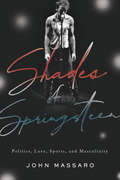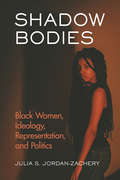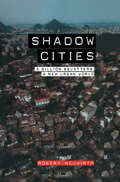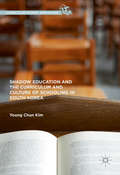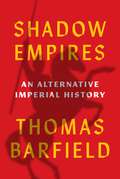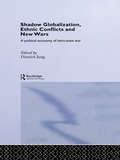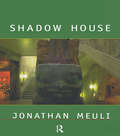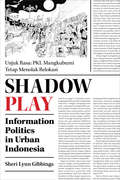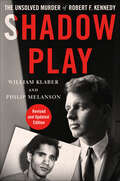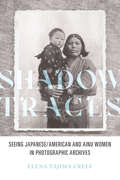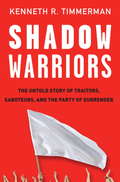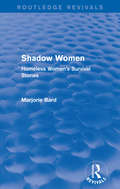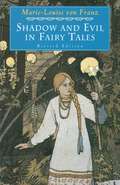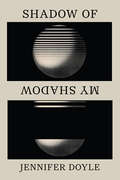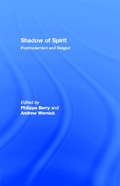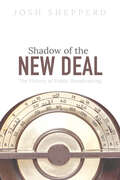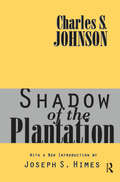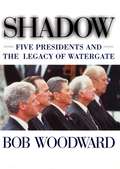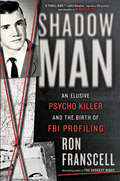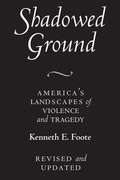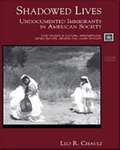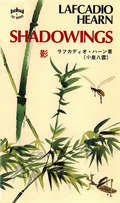- Table View
- List View
Shades of Mao: The Posthumous Cult of the Great Leader
by Geremie Barme"Essays, poems, songs, folkloric anecdotes and photographs celebrating the myth of Mao. ... The editor supplies an insightful, and cohesing introduction". -- Reference & Research Book News"(A) highly entertaining and informative collection of translations of official, admiring, tacky, but sometimes also highly critical writings, and illustrations of objects, all featuring Mao. ... A must-have book for everybody interested in contemporary China, Mao, and his legacy now and in the future". -- China Information
Shades of Springsteen: Politics, Love, Sports, and Masculinity
by John MassaroOne of the secrets to Bruce Springsteen’s enduring popularity over the past fifty years is the way fans feel a deep personal connection to his work. Yet even as the connection often stays grounded in details from his New Jersey upbringing, Springsteen’s music references a rich array of personalities from John Steinbeck to Amadou Diallo and beyond, inspiring fans to seek out and connect with a whole world’s worth of art, literature, and life stories. In this unique blend of memoir and musical analysis, John Massaro reflects on his experiences as a lifelong fan of The Boss and one of the first professors to design a college course on Springsteen’s work. Focusing on five of the Jersey rocker’s main themes—love, masculinity, sports, politics, and the power of music—he shows how they are represented in Springsteen’s lyrics and shares stories from his own life that powerfully resonate with those lyrics. Meanwhile, paying tribute to Springsteen’s inclusive vision, he draws connections among figures as seemingly disparate as James Joyce, Ta-Nehisi Coates, Thomas Aquinas, Bobby Darin, and Lin-Manuel Miranda. Shades of Springsteen offers a deeply personal take on the musical and cultural legacies of an American icon.
Shadow Bodies: Black Women, Ideology, Representation, and Politics
by Julia S. Jordan-ZacheryWhat does it mean for Black women to organize in a political context that has generally ignored them or been unresponsive although Black women have shown themselves an important voting bloc? How for example, does #sayhername translate into a political agenda that manifests itself in specific policies? Shadow Bodies focuses on the positionality of the Black woman’s body, which serves as a springboard for helping us think through political and cultural representations. It does so by asking: How do discursive practices, both speech and silences, support and maintain hegemonic understandings of Black womanhood thereby rendering some Black women as shadow bodies, unseen and unremarked upon? Grounded in Black feminist thought, Julia S. Jordan-Zachery looks at the functioning of scripts ascribed to Black women’s bodies in the framing of HIV/AIDS, domestic abuse, and mental illness and how such functioning renders some bodies invisible in Black politics in general and Black women’s politics specifically.
Shadow Cities: A Billion Squatters, A New Urban World
by Robert NeuwirthIn almost every country of the developing world, the most active builders are squatters, creating complex local economies with high rises, shopping strips, banks, and self-government. As they invent new social structures, Neuwirth argues, squatters are at the forefront of the worldwide movement to develop new visions of what constitutes property and community. Visit Robert Neuwirth's blog at: http://squatterci ty.blogspot.com
Shadow Education and the Curriculum and Culture of Schooling in South Korea (Curriculum Studies Worldwide)
by Young Chun KimThis book enables Western scholars and educators to recognize the roles and contributions of shadow education/hakwon education in an international context. The book allows readers to redefine the traditional and limited understanding of the background success behind Korean schooling and to expand their perspectives on Korean hakwon education, as well as shadow education in other nations with educational power, such as Japan, China, Singapore, and Taiwan. Kim exhorts readers and researchers to examine shadow education as an emerging research inquiry in the context of postcolonial and worldwide curriculum studies.
Shadow Empires: An Alternative Imperial History
by Thomas J. BarfieldAn original study of empire creation and its consequences, from ancient through early modern timesThe world’s first great empires established by the ancient Persians, Chinese, and Romans are well known, but not the empires that emerged on their margins in response to them over the course of 2,500 years. These counterempires or shadow empires, which changed the course of history, include the imperial nomad confederacies that arose in Mongolia and extorted resources from China rather than attempting to conquer it, as well as maritime empires such as ancient Athens that controlled trade without seeking territorial hegemony. In Shadow Empires, Thomas Barfield identifies seven kinds of counterempire and explores their rise, politics, economics, and longevity.What all these counterempires had in common was their interactions with existing empires that created the conditions for their development. When highly successful, these counterempires left the shadows to become the world’s largest empires—for example, those of the medieval Muslim Arabs and of the Mongol heirs of Chinggis Khan. Three former shadow empires—Manchu Qing China, Tsarist Russia, and British India—made this transformation in the late eighteenth century and came to rule most of Eurasia. However, the DNA of their origins endured in their unique ruling strategies. Indeed, world powers still use these strategies today, long after their roots in shadow empires have been forgotten.Looking afresh at the histories of important types of empires that are often ignored, Shadow Empires provides an original account of empire formation from the ancient world to the early modern period.
Shadow Globalization, Ethnic Conflicts and New Wars: A Political Economy of Intra-state War (Routledge Studies In New International Relations Ser.)
by Dietrich JungFocusing on the political economy of so-called new wars, this book presents a series of studies that analyse the complexities of current warfare by moving from the global sphere to local spots of organised violence. It thus raises questions about the very idea of intra-state wars and shows that these wars are inseparably linked to the global econom
Shadow House: Interpretations of Northwest Coast Art (Studies in Visual Culture #Vol. 1)
by Jonathan MeuliIn this fascinating study of Northwest Coast art, Jonathan Meuli has not only outlined a history of ideas associated with Northwest Coast art objects from pre-Contact time to the present day, but has also examined the ways in which the physical location and contexts in which the objects are produced has helped to determine their meanings. Locating his linear historical narrative within a wider exploration of ethnographic art ideas, which emphasizes links across cultures, Meuli examines the differing attitudes towards Northwest Coast material culture, particularly as these are embodied in oral mythic narratives, collection methods and architectural constructions.
Shadow Lives: Writings on Widowhood
by Uma Chakravarti Preeti GillThis volume documents the focus on the widow, regarded as the dark half of womankind in tradition, the structural counterpart of the sumangali or the auspicious married woman, and to provide an archive on widowhood.
Shadow Play: Information Politics in Urban Indonesia (Anthropological Horizons)
by Sheri Lynn GibbingsFocusing on government-organized relocations of street vendors in Indonesia, Shadow Play carefully exposes the reasons why conflicts over urban planning are fought through information politics. Anthropologist Sheri Lynn Gibbings shows that information politics are the principal avenues through which the municipal government of Yogyakarta city seeks to implement its urban projects. Information politics are also the primary means through which street vendors, activists, and NGOs can challenge these plans. Through extensive interviews and lengthy participant observation in Yogyakarta, Gibbings shows that both state and non-state actors engage in transparency, rumours, conspiracies, and surveillance practices. Gibbings reveals that these entangled information practices create suspicion and fear, form new solidarities, and dissolve relationships. Shadow Play is a compelling study explaining how we cannot understand urban projects in post-Suharto Indonesia and the resistance to them without first understanding the complexities embedded in the information practices.
Shadow Play: The Unsolved Murder of Robert F. Kennedy
by Philip Melanson William KlaberRevised and updated: The definitive account of the RFK assassination and unresolved controversies surrounding the trial of Sirhan Sirhan.On June 4, 1968, just after he had declared victory in the California presidential primary, Robert F. Kennedy was gunned down in the kitchen of the Ambassador Hotel. Captured a few feet away, gun in hand, was a young Palestinian-American named Sirhan Sirhan. The case against Sirhan was declared “open and shut” and the court proceedings against him were billed as “the trial of the century”; American justice at its fairest and most sure. But was it?By careful examination of the police files, hidden for twenty years, William Klaber and Philip Melanson’s Shadow Play explores the chilling significance of altered evidence, ignored witnesses, and coerced testimony. It challenges the official assumptions and conclusions about this most troubling, and perhaps still unsolved, political murder.
Shadow Traces: Seeing Japanese/American and Ainu Women in Photographic Archives (Asian American Experience)
by Elena Tajima CreefImages of Japanese and Japanese American women can teach us what it meant to be visible at specific moments in history. Elena Tajima Creef employs an Asian American feminist vantage point to examine ways of looking at indigenous Japanese Ainu women taking part in the 1904 Louisiana Purchase Exposition; Japanese immigrant picture brides of the early twentieth century; interned Nisei women in World War II camps; and Japanese war brides who immigrated to the United States in the 1950s. Creef illustrates how an against-the-grain viewing of these images and other archival materials offers textual traces that invite us to reconsider the visual history of these women and other distinct historical groups. As she shows, using an archival collection’s range as a lens and frame helps us discover new intersections between race, class, gender, history, and photography. Innovative and engaging, Shadow Traces illuminates how photographs shape the history of marginalized people and outlines a method for using such materials in interdisciplinary research.
Shadow Warriors: The Untold Story of Traitors, Saboteurs, and the Party of Surrender
by Kenneth R. TimmermanTimmerman contends that partisan bureaucrats at the State Department, the CIA, and other key agencies, together with Democratic politicians, are actively undermining the Bush administration policy at every turn, thus gutting America's ability to fight the War on Terror.
Shadow Women (Routledge Revivals): Homeless Women's Survival Stories
by Marjorie BardFirst published in 1990, this book emerged from the author’s experiences talking to homeless women and her desire to bring these problems to light along with the social injustice that often underlies them. The book also describes being "at risk": a paycheck, widowhood, or unfair divorce settlement away from sleeping in a car, living in malls and parks, "dining" in grocery stores. The author intends to raise awareness, participation and proposes solutions that do not simply beg more government funded shelters but rather foster self-sufficient living and working by raising self-esteem and community spirit. This book will be of interest to students of sociology.
Shadow and Evil in Fairy Tales: Revised Edition
by Marie-Louise von FranzFairy tales seem to be innocent stories, yet they contain profound lessons for those who would dive deep into their waters of meaning. In this book, Marie-Louise von Franz uncovers some of the important lessons concealed in tales from around the world, drawing on the wealth of her knowledge of folklore, her experience as a psychoanalyst and a collaborator with Jung, and her great personal wisdom. Among the many topics discussed in relation to the dark side of life and human psychology, both individual and collective, are: • How different aspects of the "shadow"—all the affects and attitudes that are unconscious to the ego personality—are personified in the giants and monsters, ghosts, and demons, evil kings and wicked witches of fairy tales • How problems of the shadow manifest differently in men and women • What fairy tales say about the kinds of behavior and attitudes that invite evil • How Jung's technique of Active imagination can be used to overcome overwhelming negative emotions • How ghost stories and superstitions reflect the psychology of grieving • What fairy tales advise us about whether to struggle against evil or turn the other cheek Dr. von Franz concludes that ever rule of behavior that we can learn from the unconscious through fairy tales and dreams is usually a paradox: sometimes there must be a physical struggle against evil and sometimes a contest of wits, sometimes a display of strength or magic and sometimes a retreat. Above all, she shows the importance of relying on the central, authentic core of our being—the innermost Self, which is beyond the struggle between the opposites of good and evil.
Shadow of My Shadow
by Jennifer DoyleOver the course of two years, Jennifer Doyle filed multiple harassment complaints with her campus’s Title IX office and one with the Department of Labor. Her experiences with these complaints and how they subsequently impacted her life have led to this book, Shadow of My Shadow. Doyle tells her personal story, sharing how she lost her sense of voice, felt exposed at work, became distrustful of students and colleagues, and was consumed by grief. Working across autobiography, literary criticism, an analysis of the Larry Nassar Title IX case, and a larger institutional critique of harassment administration, Doyle shows that harassment is at once intimate, dynamic, and intensely social, flourishing in neglected social spaces. In her own case, it profoundly reshaped her relationship to her work, her writing, and ultimately to herself. As Doyle explains, the experience drew out the distance between herself in the world and herself on the page. This book is her effort to understand and repair that breach and to consider how loss and grief can be sources of insight and compassion.
Shadow of Spirit: Postmodernism and Religion
by Philippa Berry Andrew WernickBy illuminating the striking affinity between the most innovative aspects of postmodern thought and religious mystical discourse, Shadow of Spirit challenges the long established assumption that western thought is committed to nihilism. This collection of essays by internationally recognised scholars explores the implications of the fascination with the `sacred', `divine' or `infinite' which characterizes much contemporary thought. It shows how these concerns have surfaced in the work of Derrida, Baudrillard, Lyotard, Kristeva, Irigaray and others. Examining the connection between this postmodern `turn' and the current search for a new discourse of ethics and politics, it also stresses the contribution made by feminist thought to this unexpected intellectual direction.
Shadow of the New Deal: The Victory of Public Broadcasting (The History of Media and Communication)
by Josh ShepperdDespite uncertain beginnings, public broadcasting emerged as a noncommercial media industry that transformed American culture. Josh Shepperd looks at the people, institutions, and influences behind the media reform movement and clearinghouse the National Association of Educational Broadcasters (NAEB) in the drive to create what became the Public Broadcasting Service and National Public Radio. Founded in 1934, the NAEB began as a disorganized collection of undersupported university broadcasters. Shepperd traces the setbacks, small victories, and trial and error experiments that took place as thousands of advocates built a media coalition premised on the belief that technology could ease social inequality through equal access to education and information. The bottom-up, decentralized network they created implemented a different economy of scale and a vision of a mass media divorced from commercial concerns. At the same time, they transformed advice, criticism, and methods adopted from other sectors into an infrastructure that supported public broadcasting in the 1960s and beyond.
Shadow of the Plantation
by Charles S. JohnsonShadow of the Plantation focuses on descendants of slaves in one rural Southern community in the early part of this century. In the process, Johnson reviews the troubled history of race relations in the United /States. When reread half a century after it was first written, Shadow of the Plantation is clearly revealed as a remarkably perceptive and fresh comment on race relations and the triumph of individuals over circumstances.Charles Johnson's book is significant for its use of multiple methodologies. The research took place in an ecological setting that was a dynamic element of the life of the community. The book is a multifaceted, interpretive survey of the 612 black families that composed the rural community of Macon County, Alabama, in the late 1920s and early 1930s. Johnson describes and analyzes their families, economic situation, education, religious activities, recreational life, and health practices.Shadow of the Plantation manages to be both historically accurate and foresighted at the same time. It is as much a book about today as it is a discussion of yesterday. This volume is an important study that will be of value to sociologists, anthropologists, and black studies specialists.
Shadow of the Titanic: The Extraordinary Stories of Those Who Survived
by Andrew WilsonIN the early morning hours of April 15, 1912, the icy waters of the North Atlantic reverberated with the desperate screams of more than 1,500 men, women, and children—passengers of the once majestic liner Titanic. Then, as the ship sank to the ocean floor and the passengers slowly died from hypothermia, an even more awful silence settled over the sea. The sights and sounds of that night would haunt each of the vessel’s 705 survivors for the rest of their days. Although we think we know the story of Titanic—the famously luxurious and supposedly unsinkable ship that struck an iceberg on its maiden voyage from Britain to America—very little has been written about what happened to the survivors after the tragedy. How did they cope in the aftermath of this horrific event? How did they come to remember that night, a disaster that has been likened to the destruction of a small town? Drawing on a wealth of previously unpublished letters, memoirs, and diaries as well as interviews with survivors’ family members, award-winning journalist and author Andrew Wilson reveals how some used their experience to propel themselves on to fame, while others were so racked with guilt they spent the rest of their lives under the Titanic’s shadow. Some reputations were destroyed, and some survivors were so psychologically damaged that they took their own lives in the years that followed. Andrew Wilson brings to life the colorful voices of many of those who lived to tell the tale, from famous survivors like Madeleine Astor (who became a bride, a widow, an heiress, and a mother all within a year), Lady Duff Gordon, and White Star Line chairman J. Bruce Ismay, to lesser known second- and third-class passengers such as the Navratil brothers—who were traveling under assumed names because they were being abducted by their father. Today, one hundred years after that fateful voyage, Shadow of the Titanic adds an important new dimension to our understanding of this enduringly fascinating story.
Shadow: Five Presidents And The Legacy Of Watergate
by Bob WoodwardTwenty-five years after Richard Nixon's resignation, investigative journalist Bob Woodward examines the legacy of Watergate. Based on hundreds of interviews - both on and off the record - and three years of research of government archives, Woodward's latest book explains in detail how the premier scandal of US history has indelibly altered the shape of American politics and culture - and has limited the power to act of the presidency itself. Bob Woodward's mix of historical perspective and journalistic sleuthing provides a unique perspective on the repercussions of Watergate and proves that it was far more than a passing, embarrassing crisis in American politics: it heralded the beginning of a new period of troubled presidencies. From Ford through to Clinton, presidents have battled public scepticism, a challenging Congress, adversarial press and even special prosecutors in their term in office. Now, a quarter of a century after the scandal emerged, the man who helped expose Watergate shows us the stunning impact of its heritage.
ShadowMan: An Elusive Psycho Killer and the Birth of FBI Profiling
by Ron Franscell"Mindhunter crossed with American Gothic. This chilling story has the ghostly unease of a nightmare."—Michael Cannell, author of Incendiary: The Psychiatrist, the Mad Bomber and the Invention of Criminal Profiling The pulse-pounding account of the first time in history that the FBI&’s Behavioral Science Unit created a psychological profile to catch a serial killer On June 25, 1973, a seven-year-old girl went missing from the Montana campground where her family was vacationing. Somebody had slit open the back of their tent and snatched her from under their noses. None of them saw or heard anything. Susie Jaeger had vanished into thin air, plucked by a shadow. The largest manhunt in Montana&’s history ensued, led by the FBI. As days stretched into weeks, and weeks into months, Special Agent Pete Dunbar attended a workshop at FBI Headquarters in Quantico, Virgina, led by two agents who had hatched a radical new idea: What if criminals left a psychological trail that would lead us to them? Patrick Mullany, a trained psychologist, and Howard Teten, a veteran criminologist, had created the Behavioral Science Unit to explore this new "voodoo" they called &“criminal profiling.&” At Dunbar&’s request, Mullany and Teten built the FBI&’s first profile of an unknown subject: the UnSub who had snatched Susie Jaeger and, a few months later, a nineteen-year-old waitress. When a suspect was finally arrested, the profile fit him to a T...
Shadowed Ground: America's Landscapes of Violence and Tragedy
by Kenneth E. FooteShadowed Ground explores how and why Americans have memorialized - or not - the sites of tragic and violent events spanning three centuries of history and every region of the country. For this revised edition, Kenneth Foote has written a new concluding chapter that looks at the evolving responses to recent acts of violence and terror, including the destruction of the Branch Davidian compound at Waco, Texas, the Oklahoma City bombing, the Columbine High School massacre, and the terrorist attacks of 9/11.
Shadowed Lives: Undocumented Immigrants in American Society
by Leo R. ChavezOne of the few case studies of undocumented immigrants available, this insightful anthropological analysis humanizes a group of people too often reduced to statistics and stereotypes. The hardships of Hispanic migration are conveyed in the immigrants' own voices while the author's voice raises questions about power, stereotypes, settlement, and incorporation into American society.
Shadowings
by Lafcadio HearnShadowings is made up of three parts: "Stories from Strange Books," which presents six old Japanese tales; "Japanese Studies," in which Hearn explores the lore of his adopted country; and "Fantasies," a group of essays in which he gives free rein to his wide-ranging imagination. All in all, it is a delightful collection of curiosities and fancies.

